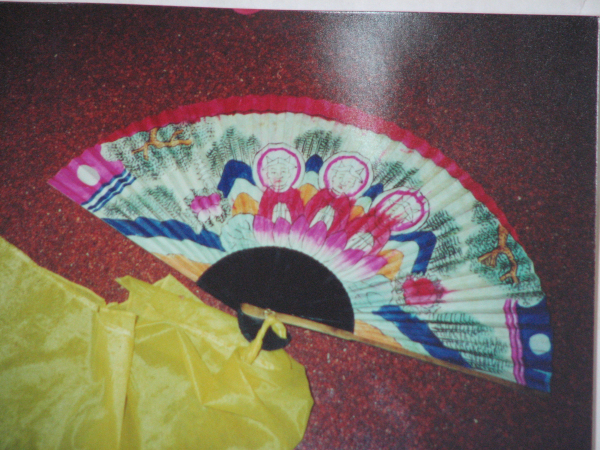한국무속신앙사전
부채 살이 쉰 개인 접부채를 의미하는 것으로, 서울굿에서 쓰이는 무구. ‘쉰대한림’, ‘꽃부채’, ‘삼불제석부채’라고도 부른다.
definition | 부채 살이 쉰 개인 접부채를 의미하는 것으로, 서울굿에서 쓰이는 무구. ‘쉰대한림’, ‘꽃부채’, ‘삼불제석부채’라고도 부른다. |
|---|---|
mp3Cnt | 0 |
wkorname | 이명숙 |
| 정의 | 부채 살이 쉰 개인 접부채를 의미하는 것으로, 서울굿에서 쓰이는 무구. ‘쉰대한림’, ‘꽃부채’, ‘삼불제석부채’라고도 부른다. | Buchae refers to the fan used as a shamanic tool in a ritual. The fan is one of the most important tools, central to the processes of a ritual. In a ritual, the shaman, as an agent of the gods, uses the fan to serve as a medium between the gods and her follower who has commissioned the ritual. When officiating a ritual or when trance channeling, the shaman has in her left hand the rattle and in her right the fan. She uses the fan to hide her face or to accept money. In shamanism, the fan is capable of chasing away evil spirits and calling in the good spirits, creating wind that washes away the wrongs of the past, brings in the good fortunes of the present, and delivers prophecies for the future. When a shaman is near death or is retiring, she passes down her fan and rattle to a younger shaman or buries them in the ground. The younger shaman who receives the fan and rattle considers herself as heir to the legacies of the older shaman, and those who discover by chance the buried tools enter the shamanic practice, considering the coincidence her fate in life. To a shaman, the fan is not a simple tool but a magical symbol that reflects that she is an agent of the gods. | 拿在手上扇动起风,是巫俗中巫师所用巫祭用具的一种。 “扇子”是巫术中最为重要的巫祭用具之一。举行巫术时巫师是神的“代理人”,通过扇子连接主家和神。在巫术场所传达神谕时,原则上巫师左手拿铃,右手拿扇。巫师在举行巫术时会用扇子遮脸或接钱。在巫俗中,扇子是可摆脱恶神并招来善神的巫师必备神具,通过扇子扇出的风可以洗去错误的过去,招来当今之福,明白未来预言之意。 巫师临近死亡或放弃从巫时,会将扇子和铃铛传给后辈巫师或埋于地下。得到扇子和铃铛的巫师被视为前辈巫师的继承者。拾到埋在地下的扇子和铃铛的人中有很多以此为缘开始从巫。对于巫师,扇子不是简单的道具,而是证明自己是神的“代理人”的咒力象征物。 | 내용 | 부채는 앉은굿과 각 거리의 신을 상징하는 특정한 무구가 있는 경우를 제외하고 서울굿의 모든 굿거리에서 쓰이는 가장 중요한 무구다. 굿에서 무당은 신의 대리인으로서 부채를 통해 [재가집](/topic/재가집)과 신을 매개한다. 신은 부채를 통해 재가집이 올린 음식을 [흠향](/topic/흠향)하고, 재가집에게 명과 복을 내리고, 재가집으로부터 별비를 받는다. 또 춤을 출 때는 소도구가 되고, 신이 현신(現身)한 경우에는 신의 위엄을 나타내 주는 도구가 되기도 한다. 특히 진오귀굿의 [도령돌기](/topic/도령돌기)에서 부채는 중요하게 쓰인다. [바리공주](/topic/바리공주)는 험한 저승길을 헤치고 망자를 저승으로 고이 모시고 가기 위해 여러 [가지](/topic/가지) 노력을 한다. 그 중 하나가 ‘부채도령’이라는 것으로, 망자의 넋이 뒤처지지 않고 잘 따라오도록 부채로 넋을 싸고돈다. 부채는 무당들이 선배 무당이나 스승 무당의 뒤를 잇는다는 상징물이기도 하다. 무당들은 죽음이 임하거나 무업을 그만둘 때, 부채와 방울을 후배 무당들에게 물려주거나 땅 속에 파묻는다. 부채와 방울을 받은 무당들은 그것을 통해 자신이 선배 무당을 계승한 것으로 여긴다. 또 땅 속에 묻은 부채와 방울을 습득한 이는 그 인연으로 인해 무업을 하는 경우가 많다. 즉, 무당에게 부채는 방울과 함께 가장 중요하게 쓰이는 무구로, 무당으로서의 정통성을 잇는 상징물이기도 하다. 방울과 부채를 습득하여 무당이 되었다는 사례가 많고, 이를 누군가로부터 받거나 줍는 꿈을 꾸고 무당이 되는 경우도 많다. 무당에게 있어 부채는 단순한 도구가 아니라 자신이 신의 대리인이라는 것을 나타내는 주술적인 상징물이다. | 참고문헌 | 한국의 무 (조흥윤, 정음사, 1983) 서울지역 무구의 신화·의례적 기능 연구 (이명숙, 한국무속학 8, 한국무속학회, 2004) 인간과 신령을 잇는 상징, 무구-서울시·경기도·강원도 (국립문화재연구소, 2005) | Buchae es el término que hace referencia al abanico utilizado como un medio en los rituales chamánicos. El abanico es uno de los instrumentos más importantes para llevar a cabo los procedimientos de los rituales. En un ritual, el chamán usa el abanico como un agente de los dioses para servir como un medio entre los dioses y sus creyentes que ha acogido el ritual. Al oficiar un ritual o canalizar en trance, el chamán tiene un sonajero en la mano izquierda y un abanico en la mano derecha. él utiliza el abanico para ocultar su cara o aceptar donaciones. En el ámbito del chamanismo, el buchae es capaz de ahuyentar los espíritus malignos y llamar a los espíritus buenos, creando el viento que elimina los errores del pasado, brinda la buena fortuna en el presente y hacer predicciones sobre el futuro. Cuando un chamán está a punto de morir o retirarse, él deja en herencia su abanico y sonajero a otro chamán joven, o los entierran en el suelo. Entonces el chamán joven que ha recibido el abanico y sonajero se considera a sí mismo como heredero del chamán mayor. En el caso de que alguien encuentre por casualidad los instrumentos enterrados deberá iniciar sus prácticas chamánicas, considerando que esa coincidencia sería su inevitable destino. Para un chamán, el abanico denominado buchae no es un medio simple, sino un símbolo mágico que refleja que él es un agente de los dioses. | 형태 | 대나무 부채 살 위에 노란색 천을 붙이고 그 위에 그림을 그린다. 중앙에 삼불제석을 앉히고, 그 좌우로 탑, 소나무, 해, 달, 구름, 연꽃, 무지개 등을 배치한다. 예전에는 부채살이 쉰개라서 쉰대부채라고 불렸다고 하는데, 현재 쓰이는 살은 22, 24, 27개 등으로 현저히 줄어든 형편이다. 해, 달, 구름 등은 일월성신(日月星辰) 등 높은 신령을 뜻하며, 소나무는 신의 근본을 뜻한다. 부채 끝에는 부채끈이라는 노란색 천이 40~100㎝ 내외로 달려 있다. 부채끈의 길이는 무당마다 약간씩 차이가 있다. |
|---|
| 巫黨來歷 | 이화여자대학교 출판부 | 한국복식사연구 | 유희경 | 1975 | 열화당 | 한국의 무당 | 최길성 | 1981 | 집문당 | 한국무속연구 | 김태곤 | 1981 | 한국방송통신대학논문집 5 | 무당내력을 중심으로 한 무속복식연구 | 백영자·유효순 | 1986 | 집문당 | 한국무속사상연구 | 김인회 | 1988 | 숙명여자대학교 박사학위논문 | 한국종교복식에 관한 연구 | 임영자 | 1989 | 교문사 | 한말의 궁중무속 | 최길성 | 1989 | 경춘사 | 한국의 복식 | 백영자 | 1993 | 숙명여자대학교 박사학위논문 | 한국의 무속복식 연구 | 유효순 | 1994 |
|---|
| 삼불제석부채 |  64894 삼불제석부채 |
|---|---|
| 쉰대부채 |  64660 쉰대부채 |
0 Comments














